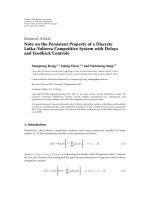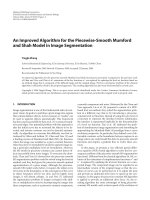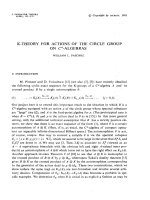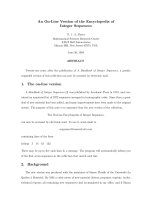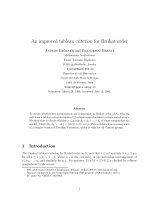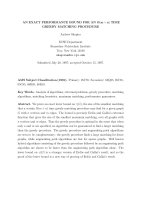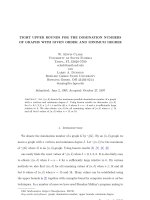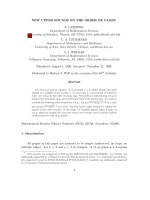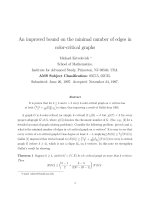Báo cáo toán học: "An improved bound on the minimal number of edges in color-critical graphs" pot
Bạn đang xem bản rút gọn của tài liệu. Xem và tải ngay bản đầy đủ của tài liệu tại đây (60.78 KB, 4 trang )
An improved bound on the minimal number of edges in
color-critical graphs
Michael Krivelevich
∗
School of Mathematics,
Institute for Advanced Study, Princeton, NJ 08540, USA.
AMS Subject Classification: 05C15, 05C35.
Submitted: June 26, 1997. Accepted: November 24, 1997.
Abstract
It is proven that for k ≥ 4 and n>kevery k-color-critical graph on n vertices has
at least
k−1
2
+
k−3
2(k
2
−2k−1)
n edges, thus improving a result of Gallai from 1963.
A graph G is k-color-critical (or simply k-critical)ifχ(G)=kbut χ(G
) <kfor every
proper subgraph G
of G, where χ(G) denotes the chromatic number of G. (See, e.g., [2] for a
detailed account of graph coloring problems). Consider the following problem: given k and n,
what is the minimal number of edges in a k-critical graph on n vertices? It is easy to see that
every vertex of a k-critical graph G has degree at least k − 1, implying |E(G)|≥
k−1
2
|V(G)|.
Gallai [1] improved this trivial bound to |E(G)|≥
k−1
2
+
k−3
2(k
2
−3)
|V (G)| for every k-critical
graph G (where k ≥ 4), which is not a clique K
k
on k vertices. In this note we strengthen
Gallai’s result by showing
Theorem 1 Suppose k ≥ 4, and let G =(V,E) be a k-critical graph on more than k vertices.
Then
|E(G)|≥
k−1
2
+
k−3
2(k
2
− 2k − 1)
|V (G)| .
∗
e-mail:
1
the electronic journal of combinatorics 1 (1998), #R4 2
In the first non-trivial case k = 4 we get |E(G)|≥
11
7
|V (G)|, compared to the estimate
|E(G)|≥
20
13
|V (G)| of Gallai.
Let us introduce some definitions and notation (we follow the terminology of [4]). If
G =(V,E)isak-critical graph, then the low-vertex subgraph of G, denoted by L(G), is
the subgraph of G, induced by all vertices of degree k − 1. The high-vertex subgraph of G,
which we denote by H(G), is the subgraph of G induced by all vertices of degree at least k
in G. Brooks’ theorem implies that if k ≥ 4 and G = K
k
, then H(G) = ∅. A maximal by
inclusion connected subgraph B of a graph G such that every two edges of B are contained
in a cycle of G is called a block of G. A connected graph all of whose blocks are either
complete graphs or odd cycles is called a Gallai tree,aGallai forest is a graph all of whose
connected components are Gallai trees. A k-Gallai forest (tree) is a Gallai forest (tree), in
which all vertices have degree at most k − 1.
Our proof utilizes results of Gallai [1] and Stiebitz [5], describing the structure of color-
critical graphs. Gallai proved the following fundamental result.
Lemma 1 ([1], Satz E.1) If G is a k-critical graph then its low-vertex subgraph L(G) is a
k-Gallai forest (possibly empty).
Using induction on the number of vertices, it follows from the above statement that
Lemma 2 ([1], Lemma 4.5) Let k ≥ 4.LetG=(V,E) = K
k
be a k-Gallai forest. Then
|E(G)|≤
k−2
2
+
1
k−1
|V(G)|−1. (1)
The second ingredient of our proof is the following result of Stiebitz.
Lemma 3 ([5]) Let G be a k-critical graph containing at least one vertex of degree k − 1.
Then the number of connected components of its high-vertex subgraph H(G) does not exceed
the number of connected components of its low-vertex subgraph L(G).
Proof of Theorem 1. Let L(G) and H(G) be the low-vertex and the high-vertex subgraphs
of G, respectively. Denote n
L
= |V (L(G))|, n
H
= |V (H(G))|, n = |V (G)| = n
L
+ n
H
.By
Brooks’ theorem n
H
> 0. Also, if V (L(G)) = ∅, we are done, therefore we may assume that
n
L
> 0.
the electronic journal of combinatorics 1 (1998), #R4 3
Let r be the number of connected components of H(G), then trivially
|E(H(G))|≥n
H
−r. (2)
Also, by Lemma 3, the number of connected components of L(G) is at least r. Now the crucial
observation is that each connected component of L(G) is itself a k-Gallai tree, therefore the
estimate (1) is valid for it too. We infer that
|E(L(G))|≤
k−2
2
+
1
k−1
n
L
−r. (3)
Indeed, if G
1
=(V
1
,E
1
), ,G
r
=(V
r
,E
r
) are the connected components of L(G
), where
r
≥ r, then by Lemma 1
|E
i
|≤
k−2
2
+
1
k−1
|V
i
|−1,i=1, ,r
.
Summing the above inequalities over 1 ≤ i ≤ r
, we get (3).
Using (2) and (3), the number of edges of G can be bounded from below as follows:
|E(G)| =
v∈V (L(G))
d(v) −|E(L(G))| + |E(H(G))|
≥ (k − 1)n
L
−
k − 2
2
+
1
k − 1
n
L
+ r + n
H
− r
= n +
k
2
− 3k
2(k − 1)
n
L
. (4)
On the other hand, it follows from the definition of L(G) and H(G) that
|E(G)| =
1
2
v∈V (G)
d(v)=
1
2
v∈V(L(G))
d(v)+
v∈V(H(G))
d(v)
≥
1
2
((k − 1)n
L
+ kn
H
)=
k
2
n−
1
2
n
L
. (5)
Multiplying (5) by (k
2
− 3k)/(k − 1) and summing with (4) we get
1+
k
2
−3k
k−1
|E(G)|≥
1+
k
2
k
2
−3k
k−1
n,
or
|E(G)|≥
k−1
2
+
k−3
2(k
2
− 2k − 1)
n,
the electronic journal of combinatorics 1 (1998), #R4 4
as claimed. ✷
A more detailed treatment of the problem, containing lower and upper bounds on the
minimal number of edges in a k-critical graph on n vertices with additional restrictions
imposed, and some applications of these bounds to Ramsey-type problems and problems on
random graphs, will appear in a forthcoming paper [3].
References
[1] T. Gallai, Kritische Graphen I, Publ. Math. Inst. Hungar. Acad. Sci. 8 (1963), 265–292.
[2] T. R. Jensen and B. Toft, Graph coloring problems, Wiley, New York, 1995.
[3] M. Krivelevich, On the minimal number of edges in color-critical graphs, Combinatorica,
to appear.
[4] H. Sachs and M. Stiebitz, Colour-critical graphs with vertices of low valency, Annals of
Discrete Math. 41 (1989), 371–396.
[5] M. Stiebitz, Proof of a conjecture of T. Gallai concerning connectivity properties of
colour-critical graphs, Combinatorica 2 (1982), 315–323.
